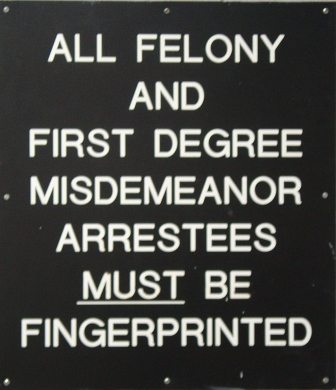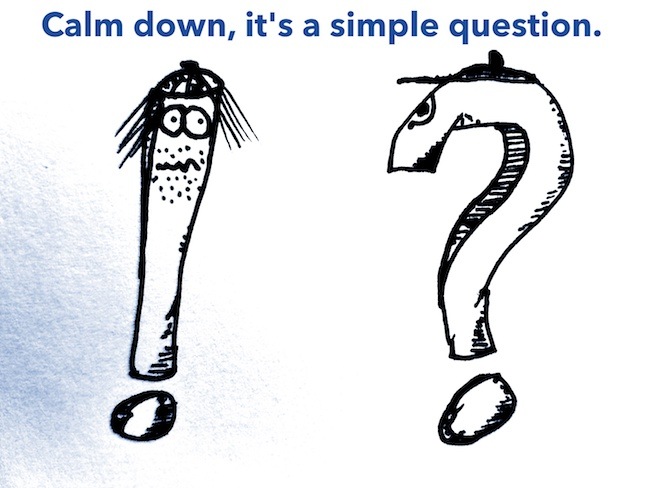Do you ever find yourself searching for the perfect word(s) to help paint a scene with a bit more color and dazzle? Do your characters mumble and grumble about wanting to appear as if they know what they’re doing and saying, instead of sounding like the cliche’-spouting folks on television crime shows?
If so, you might want to toss a few of these terms into your go-to box of words.
E.
Edge Characteristic – The physical characteristics of the periphery of a bloodstain.
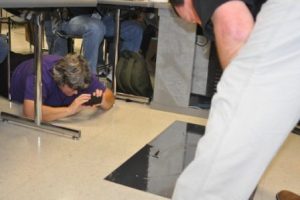
Author Donna Andrews photographs print found using electrostatic dust print lifter during a Writers’ Police Academy workshop.
Electrostatic dust print lifter − A system that applies a high-voltage electrostatic charge on a piece of lifting film, causing dust or residue particles from a print to transfer to the underside of the lifting film. Some of you may remember seeing this process in use at the Writers’ Police Academy.
Expiration Pattern – A bloodstain pattern resulting from blood forced by airflow out of the nose, mouth, or a wound. (Expiration – exhalation of breath).
Extreme Conduct – A defendant may receive an upward departure (a longer sentence) from the guidelines range if the commission of the crime was exceptionally heinous, cruel, brutal, or degrading to the victim. Likewise, An upward departure from the guidelines may be warranted if a victim suffered extreme psychological injury that’s deemed exceptionally more serious than that normally resulting from commission of the crime.
Brutally maiming and murdering federal agents simply because they dared to ask questions (revenge), well, that may be a crime that warrants an upward departure from the typical sentence.
Federal Sentencing Guidelines – Federal Sentencing Guidelines are rules that determine how much, or how little, prison time a federal judge may impose on a defendant who has been found guilty of committing a federal crime.
To read more about Federal Sentencing Guidelines, click here.
Felony – An offense punishable by a prison term of one year or more.
Felony Murder: A killing that takes place during the commission of another dangerous felony, such as robbery.
To get everyone’s attention, a bank robber fires his weapon at the ceiling. A stray bullet hits a customer and she dies as a result of her injury. Then the robber turns toward the bank manager to order him to stay put and, while in the process, accidentally stabs and kills the man with the knife he held in his non-gun hand, the implement he’d planned to use to cut open sealed money bags. The robber has committed felony murder, a killing, however unintentional, that occurred during the commission of a felony. The shooter’s accomplices, assessors after the fact, could also be charged with the murder even if they were not in possession of a weapon or took no part in the death of the victim.
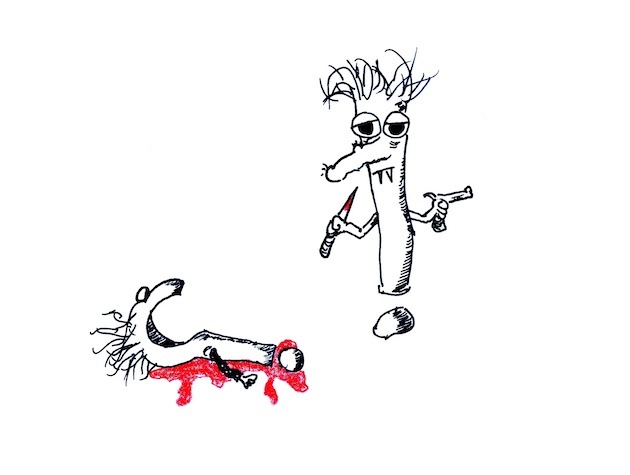
Firing pin/striker – The component/part of a firearm that contacts the ammunition causing it to fire.
Forward Spatter Pattern – A bloodstain pattern resulting from blood drops that traveled in the same direction as the the item causing the force (A baseball bat in motion).
G.
Gabaloo – a real dumbass who believes he’s heaven’s gift to everything on earth—the best singer, the sexiest, etc.
Gag Order – When a defendant becomes unruly a judge may order that he be bound and gagged to prevent further disruptions. The term is also used when a judge orders attorneys, witnesses, etc. to not discuss a case outside the courtroom. Note – Some would prefer the bound and gagging approach be used on attorneys as well as a defendant/client.
Gear Hound – An officer who has far more equipment than that issued by the department. A gear hound is frequently seen shopping in police supply stores.
Get Small – Hide, or run away.

Ghetto Bird – Police helicopter.
Ghetto Cattle – A pack of feral or abandoned dogs.
Ghost Riding – A patrol car rolling down the street without a driver. Officers sometimes are in such a hurry when arriving at the scene they simply forget to shift to park.
GGW – Girls gone wild.
Gh3tto – Gangster
Good Cause – A legal excuse for doing something that’s typically considered illegal. (Think politicians).
Good Moral Character – Do NOT think politicians.
Good Time Credit – Federal prisoners may earn sentence reductions of up to 54 days per year a for their good conduct while in prison. The Bureau of Prisons (BOP) awards the credits, not the courts, and they apply only to sentences greater than 12 months. Good time credits may be revoked should an inmate commit rule infractions during their incarceration period—fighting, stealing, possession of contraband such as drugs, weapons, or other prohibited material.
Federal prisoners who play nice during the course of their time behind bars typically see a substantial accumulation of good time credit and will subsequently hit the streets much sooner than those who repeatedly act like idiots.

Due to earned good time credit, federal prisoners who follow the rules are typically released after serving approximately 85% of their sentence.
Gorilla Anus/Gorilla Ass – term used when someone refuses to do something you want them to do. “No, Lil’ Dirt Bag won’t go to the store to get me no Cheetos. He’s being a real gorilla ass.”
Gorilla Biscuits – an old street term for meth. Zookeepers may have another definition.
Grass Widow – A woman separated from her husband by abandonment.
Grill – Teeth, or face.

H.
Habeus Corpus – To bring a party before the judge. The most common of the writs is to release a prisoner from unlawful imprisonment. Jailhouse lawyers make a living drafting these for fellow inmates.
Habeus Grab-Ass – To catch/arrest a suspect.
Hairbag – Rookie who thinks he knows it all, even if he’s only been on the job for an hour.
Hatch Act – Statute prohibiting federal, state, and local employees from participating in certain political activities.
Hate Crime Motivation – If it’s proven beyond any reasonable doubt that a defendant intentionally selected a victim because of their race, color, religion, national origin, ethnicity, gender, gender identity, disability or sexual orientation, the courts may impose a sentence enhancement/upward departure of the guidelines.
Hats and Bats – Riot gear—helmets and batons.
Horner – A person/addict who inhales/snorts heroin rather than inject it.
Hillbilly Meth – Mountain Dew (soft drink). The soda was given the nickname due to its high sugar content.
Holster Sniffer – A woman who has sex with cops simply because they’re cops. AKA – Holster Humper, Cop Stalker, Badge Bunny.
Homogenization – process of preparing tissue for analysis by grinding it in a specific amount of water (precisely measured, of course).
Horizontal Highway Hostess – Prostitute who works the streets.
House Mouse – Officer who typically works behind a desk.
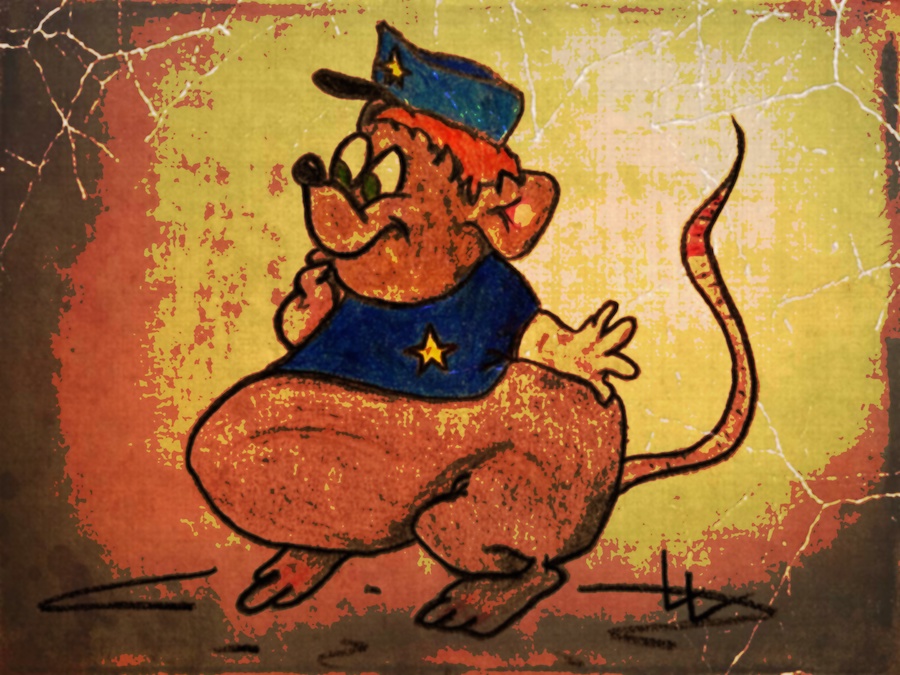
House Mouse
Hurrication – Time off work due to do storms.
Hooptie – Any car that’s still rolling despite troubles, such as windows that won’t roll up or down, hood or trunk lid wired shut with baling wire, missing window glasses covered with garbage bags and duct tape, broken taillights covered with red duct tape, missing hubcaps, radio antennae missing but replaced with coat hanger, and so on. “Lawdy, is Bubba still driving that old hooptie car his daddy bought from the junk yard? “
Hot Blood – When someone’s emotions/passions have been heightened to an uncontrollable degree. A case of “hot blood” may be cause to reduce a murderer’s charge to a lesser offense.
Hydrant Humper – Firefighter.
Hulk-Out – To become extremely angry in an instant. “Seargent, be careful with that guy. He’ll hulk-out on you in a heartbeat. Took six of us to get him cuffed last time.”
I.
Impact Pattern – A bloodstain pattern resulting from an object striking liquid blood.
Impression evidence – Materials that keep the characteristics of other objects that have been pressed against them, such as a footprint in mud.
Indictment – A formal, written accusation of a crime made by a Grand Jury. An indictment, once issued, is then presented to a court at which time begins the prosecution of the defendant.
Information – Like an indictment, an Information is a formal, written accusation of a crime. However, the Information is made by a prosecutor, not Grand Juries. This typically occurs in areas where Grand Juries are not utilized.
J.
Judgment and Commitment – Or simply, the “judgment,” is a written record of the defendant’s convictions the sentences.
K.
Kidnapping – An abduction, taking of a hostage, or unlawfully restraining a person to facilitate the commission of an crime. An upward departure of sentencing may be warranted in either of these instances.

L.
Latent print – A print that is not visible under normal lighting.
Locard’s Exchange Principle – The theory that every person who enters or leaves an area will deposit or remove physical items from the scene.
Locus – The specific location of a gene on a chromosome; the plural form is loci.
Luminol – A chemical that exhibits chemiluminescence, a blue glow, when mixed with an oxidizing agent. Luminol is used detect trace amounts of blood left at crime scenes as it reacts with iron found in hemoglobin. Horseradish can leave a flash positive, but its glow is not as bright as the glow produced by blood. Other items could also produce false positives, but they, too, do not glow as brightly as blood.
M.
Magazine – A container that feeds cartridges into the chamber of a firearm.
Mandatory Minimum – Non-discretionary penalties required by law, such as the federal drug offenses that carry mandatory minimum penalties.
*See Federal Sentencing Guidelines above. To read more about Federal Sentencing Guidelines, click here.
Misdemeanor: A crime that’s typically punishable by one year of imprisonment, or less.
Misprision of a Felony – The concealment and/or nondisclosure of a felony by a person who did not participate in the committed crime. Example – John Iseenit, the man who knows that his friend, Bill Idunit, robbed a bank, yet he allows Bill to hide out in his home along with the stolen cash. When the cops stop by to ask if John knows Bill’s whereabouts, he lies and says he does not.

Mist Pattern – A bloodstain pattern resulting from blood reduced to a fine spray as a result of an applied force.
Mitochondrial DNA (mtDNA) – DNA located in the mitochondria found in each cell of a body, with the exception of red blood cells. mtDNA can be used to link a common female ancestor.
N.
Nuclear DNA – DNA located in the nucleus of a cell. Red blood cells do not contain nuclei; therefore, they do not contain DNA.
O.
Obstruction of Justice: Obstruction of Justice is a very broad term that simply boils down to charging an individual for knowingly lying to law enforcement in order to change to course/outcome of a case, or lying to protect another person. The charge may also be brought against the person who destroys, hides, or alters evidence.
For more about obstruction, see When Lying Becomes A Crime: Obstruction Of Justice
Offense Level: The severity level of an offense as determined by the Federal Sentencing Guidelines.
Federal Sentencing Guidelines are rules that determine how much or how little prison time a federal judge may impose on a defendant who has been found guilty of committing a federal crime.
To learn more about these guidelines, go here … So, You’ve Committed a Federal Offense: How Much Time Will You Serve?
Order – The written command issued by a court or a judge.
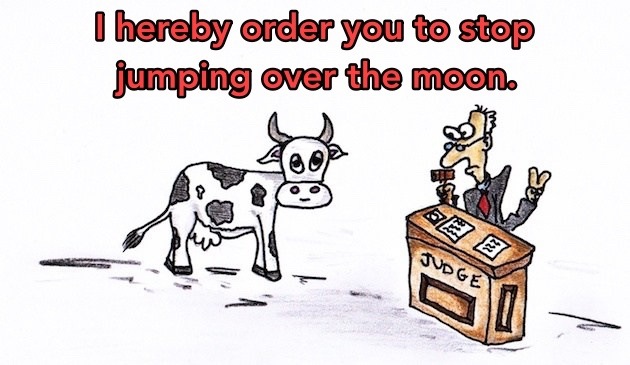
P.
Parent Stain – A bloodstain from which a satellite stain originated.
Parole: The early and conditional release from prison. Should the parolee violate those conditions, he/she could be returned to prison to complete the remainder of their sentence. Parole, however, was abolished in the federal prison system in 1984. In lieu of parole, federal inmates earn good time credits based on their behavior during incarceration. Remember, federal inmates may earn a sentence reduction of up to 54 days per year. Good time credits are often reduced when prisoners break the rules, especially when the rules broken are serious offenses—fighting, stealing, possession of contraband such as drugs, weapons, or other prohibited material.
* Writers, please remember this one. There is no parole in the federal system. People incarcerated in federal prison after 1984 are not eligible for parole because is does not exist. I see this all the time in works of fiction.
Pistol – A handgun which uses a magazine and ejects fired cartridge cases automatically.
Plasma – The clear, yellowish fluid portion of blood.
Plastic − A type of print that is three-dimensional.
Platelet – An irregularly shaped cell-like particle in the blood that is an important part of blood clotting. Platelets are activated when an injury breaches a blood vessel to break. Platelets then change shape and begin adhering to the broken vessel wall and to each other. This is the start of the clotting process.
Plea Bargain/Agreement – an agreement whereby a defendant enters a guilty plea to avoid proceeding to trial. The agreement contains promises made by both the prosecutor and defendant, and each must must each abide by those written guarantees. Each party benefits in some way. The prosecutor avoids a lengthy and costly trial while maintaining a desired conviction rate. The defendant typically receives a shorter, more lenient sentence for agreeing to help the prosecutor maintain that upper level conviction rate.
Pool – An accumulation of liquid blood on a surface.
Post-mortem redistribution – Toxicological phenomenon of an increase in drug concentration after death.
Pre-sentence Report (“PSR”) – Prior to sentencing, a probation officer must thoroughly investigate all aspects of a defendant’s life—criminal history, family ties, work record, community ties, etc. This information is then compiled into a comprehensive report that’s filed with the courts, under seal. Also contained in the pre-sentence report is information about the offense and offender, the mandatory range of punishment, and recommendations and basis for imposing a departure above or below the guideline range.
Primer – The chemical composition that, when struck by a firing pin, ignites smokeless powder., NOT CORDITE!
Probation – A sentence option that allows a defendant to avoid imprisonment. Although, it’s common to see sentences comprised of some probation in conjunction with short stays in prison, such as the sentence of five years that’s split as three years behind bars with the balance of two years served as probation (this is known as a “split sentence”). Or, a sentence may be served as weekends in jail, confinement in halfway house where the offender is allowed to work during the day but return to the halfway house at night. Even home detention is a prison or jail sentence. It’s merely served in a unique way.. A person on probation is monitored by a probation officer and must follow all rules issued by the judge. Should probationer break a rule, he may be ordered back to prison to serve the remainder of their sentence.

Bloodstain pattern investigation workshop #2017WPA
Projected Pattern – A bloodstain pattern resulting from liquid blood that’s leaking while under pressure, such as a spurt or spray.
R.
Revocation – The cancellation or reversal of an act or court order, such as when an offender violates the terms of supervised probation. The probation officer would ask that the judge revoke the offender’s supervised release and return them to prison to serve the remainder of their sentence. Prisoners refer to this action as being violated.
“Why are you back in the joint, Petey?” said One-Tooth McGee.
“That &%*# probation officer violated me,” Petey said.
Revolver – A handgun that has a rotating cylinder. Cartridge casings are not automatically ejected when fired.
S.
Saturation Stain – A bloodstain resulting from the accumulation of liquid blood in an absorbent material, such as clothing or bedding.
Sentencing Table Sentencing guideline, in months. See So, You’ve Committed a Federal Offense: How Much Time Will You Serve?
Serum Stain – The stain resulting from the liquid portion of blood (serum) that separates during coagulation.
Spatter Stain – A bloodstain resulting from a blood drop dispersed through the air due to an external force (a bullet, bat, hammer, rock, etc.).
Spines – A bloodstain feature resembling rays/lines emanating out from the edge of a blood drop.
Splash Pattern – A bloodstain pattern resulting from a volume of liquid blood that falls and or spills onto a surface.
Substantial Assistance – Assisting the government in its investigation and/or prosecution of another individual in return for a reduced sentence. *See “Departure” above.
Swipe Pattern – A bloodstain pattern resulting from the transfer of blood from a blood-stained surface onto another surface, such as the swipe/wipe of a rag or cloth through a bloody area.
T.
Tertiary DNA Transfer – DNA can be accidentally transferred from one object to another. A good example could be the killer who shares an apartment with an unsuspecting friend. He returns home after murdering someone and then tosses his blood-spatter-covered shirt into the washer along with his roommate’s clothing. The machine churns and spins through its wash cycles, an action that spreads the victim’s DNA throughout the load. Police later serve a search warrant on the home, seize the clothing, and discover the victim’s DNA on the roommate’s jeans. The innocent roommate is arrested for murder.

Tertiary Transfer of DNA Evidence
The same can occur with touch DNA. A man shares a towel with his wife and his DNA is subsequently transferred to her face and neck. Later, a stranger wearing gloves chokes the woman to death, transferring the husband’s DNA from the victim’s face to the killer’s gloves. The assailant removes the gloves and leaves them at the scene. Police confiscate the gloves, test them, and find the husband’s DNA. He is then charged for his wife’s death while the real killer is free to murder again.
The example above (the choking case) actually happened, and those of you who attended the Writers’ Police Academy session taught by DNA expert Dr. Dan Krane heard him speak of it. He was the expert who proved this was indeed possible and he testified to it in the groundbreaking case involving accused killer Dr. Dirk Grenadier.
Transfer Stain – A bloodstain resulting from contact between a bloodstained surface and another area/item.

Crime Scenes … Watch Your Step!
Transient evidence – Evidence that could lose its evidentiary value if not protected, such as blood, semen, fingerprints exposed to the rain.
V.
Vacate – Based on a factual error, to void a sentence and then remand it back to the original court for re-sentencing.
Void – An absence of blood in an otherwise continuous bloodstain pattern.
W.
Waive – To validly give up a right, such as a right to trial or the right to remain silent.
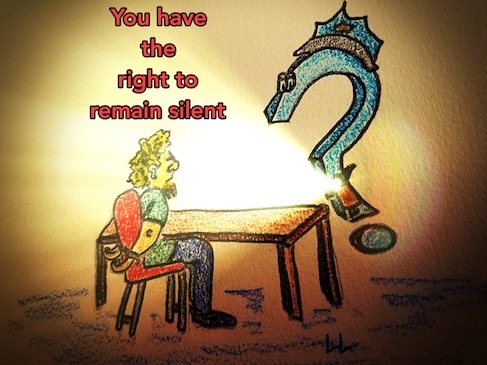
Wipe Pattern – An altered bloodstain pattern caused when an object passes through a wet bloodstain.


